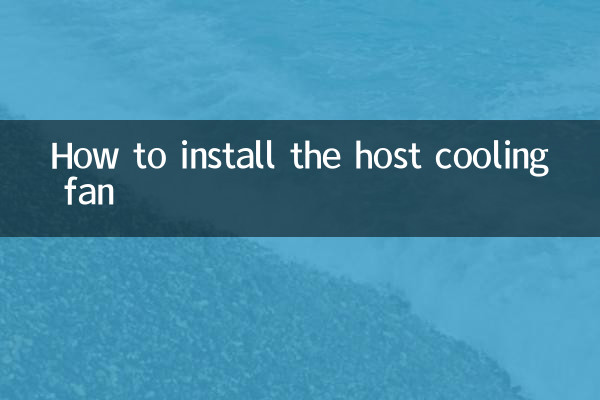How to install the host cooling fan
With the arrival of high temperatures in summer, the heat dissipation problem of computer hosts has become the focus of many users. Proper cooling fan installation can not only improve host performance but also extend hardware life. This article will introduce in detail the installation steps, precautions and recent hot topics of heat dissipation of the host cooling fan to help users easily solve heat dissipation problems.
1. Recent hot topics on heat dissipation (last 10 days)

| hot topics | Discussion popularity | main focus |
|---|---|---|
| Water cooling vs air cooling | high | Performance comparison, installation difficulty |
| Recommended silent cooling fan | in | Noise control, cost performance |
| Cooling effect of RGB fan | in | Balance of aesthetics and performance |
| Host cooling in hot weather | high | Solutions for extreme temperatures |
2. Cooling fan installation steps
1.Preparation
Before installing the cooling fan, you need to prepare the following tools and materials: screwdriver, cooling fan, silicone grease (if you need to replace the CPU radiator), and cable ties (for cable management).
2.Locate the fan
There are usually multiple fan installation positions inside the host. Common locations include:
| location | function |
|---|---|
| Front fan | Breathe in cold air |
| rear fan | expel hot air |
| top fan | Auxiliary heat removal |
| CPU cooling fan | Directly cools the CPU |
3.Install fan
(1) Align the fan to the installation position and pay attention to the inlet and outlet directions of the fan (usually marked by arrows).
(2) Use screws or buckles to fix the fan to ensure stability.
(3) Connect the fan power cable to the "SYS_FAN" or "CHA_FAN" interface on the motherboard.
4.Cabling and testing
After installation is complete, use cable ties to organize the wires to avoid affecting the air duct. Boot into the BIOS and check whether the fan is running normally.
3. Precautions
1.Air duct design: Ensure that the fan forms a reasonable air channel of "forward and then out" or "bottom in and top out".
2.fan direction: Installing it backwards will lead to a decrease in heat dissipation efficiency. Be sure to check the arrow mark.
3.Compatibility: Confirm that the fan size (such as 120mm, 140mm) matches the chassis support position.
4.Noise control: High-speed fans may be noisy, and the speed curve can be adjusted through the BIOS.
4. Recommendations for popular cooling fans
| Brand model | Type | Speed (RPM) | Noise (dB) |
|---|---|---|---|
| Noctua NF-A12x25 | air cooling | 2000 | 22.6 |
| Corsair LL120 RGB | RGB air cooling | 1500 | 24.8 |
| NZXT Kraken X63 | water cooling | 1800 (pump speed) | 21-36 |
5. Summary
Correct installation of cooling fans can significantly improve the temperature of the host, especially during high temperature seasons. There has been a lot of discussion recently about water cooling and air cooling, and users can choose a solution based on their needs. When installing, pay attention to the air duct design, direction and compatibility, and give priority to silent performance. Regularly cleaning fan dust is also key to maintaining cooling efficiency.

check the details

check the details